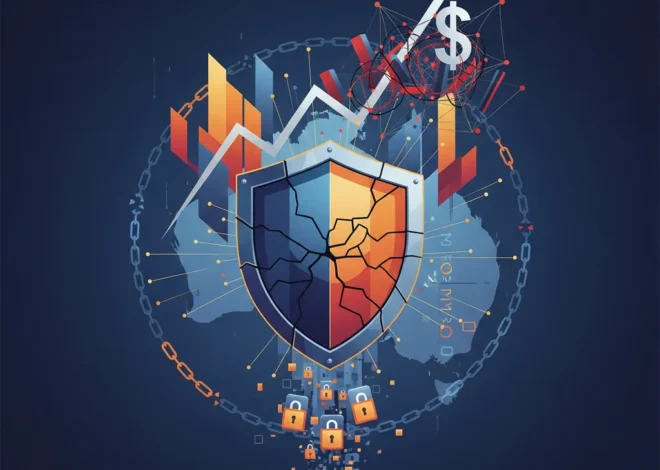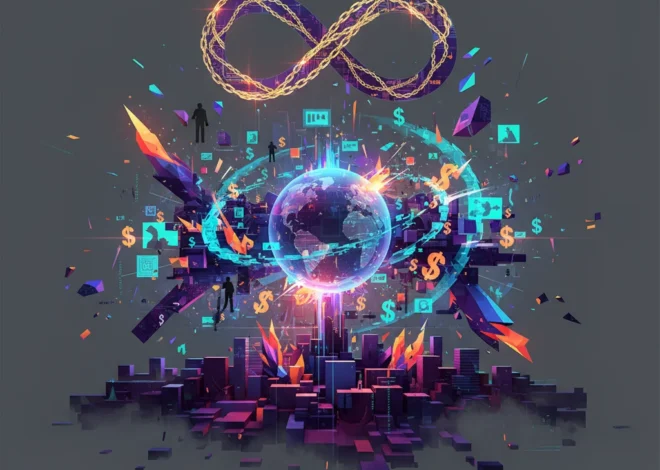
Market Tremors: Analyzing the Financial Fallout of a Public Safety Crisis
In a stark reminder of the fragility of public safety, a recent incident on a train north of London resulted in the arrest of two individuals after a mass stabbing. The involvement of Counter Terror Police in the investigation, as reported by the Financial Times, underscores the severity of the attack which left nine people with life-threatening injuries. While the immediate and most important focus remains on the victims and the swift response of emergency services, events of this nature send powerful and often unseen shockwaves through the financial and economic landscape.
For investors, business leaders, and finance professionals, understanding these ripples is not merely an academic exercise—it is a critical component of risk management, strategic planning, and navigating an increasingly volatile world. A localized public safety crisis, especially one with potential terror links, can trigger a cascade of effects that influence everything from the stock market and investor sentiment to consumer behavior and long-term economic policy. This analysis will dissect the multifaceted financial fallout of such an event, exploring the immediate market reactions, the broader macroeconomic implications, and the evolving role of financial technology in a world grappling with new and unpredictable threats.
The Immediate Market Reaction: A Flight to Safety
Financial markets are, at their core, a reflection of collective human psychology, and they react to fear and uncertainty with swift, predictable patterns. A high-profile security incident, such as the one reported north of London, acts as a classic “exogenous shock” to the system. The first and most immediate reaction is typically a “flight to safety,” a phenomenon where investors rapidly sell off what they perceive as risky assets and move their capital into safer havens.
This behavior is often visible within minutes of the news breaking, as algorithmic trading systems and human traders alike respond to the sudden injection of risk. We typically see:
- Equities Under Pressure: Broad market indices may dip as investors de-risk their portfolios. The impact is rarely uniform; specific sectors directly related to the incident often bear the brunt of the sell-off. Transportation stocks (airlines, rail operators), tourism and hospitality companies (hotels, restaurants), and public venue operators can see sharp declines in their stock prices.
- Rise of the “Fear Index”: The CBOE Volatility Index (VIX), often referred to as the market’s “fear gauge,” tends to spike. A rising VIX indicates that traders are anticipating higher volatility in the stock market, and they are willing to pay a premium for options that protect them against a downturn.
- Strength in Safe Havens: Assets perceived as stable stores of value typically rally. This includes government bonds from stable economies (like U.S. Treasuries or German Bunds), precious metals like gold, and certain currencies such as the U.S. dollar, Swiss franc, and Japanese yen.
Conversely, some sectors may experience a surge in investor interest. Companies in the defense, cybersecurity, and private security industries often see their valuations climb as the market prices in an anticipated increase in government and corporate spending on security measures. This immediate re-pricing of risk across the stock market is a powerful illustration of how a single event can instantly alter the financial landscape.
Beyond the Banners: What the Edinburgh Protests Mean for the Global Economy and Your Portfolio
Sectoral Impact Analysis: A Deeper Dive
The economic repercussions of a public safety crisis are not monolithic. Different sectors of the economy experience the shock in unique ways, with both short-term and long-term consequences. The following table provides a high-level analysis of the potential impact on key industries.
| Sector | Potential Short-Term Impact | Potential Long-Term Impact |
|---|---|---|
| Transportation & Logistics | Immediate service disruptions, decreased passenger volume due to fear, increased security costs, and higher insurance premiums. | Permanent increases in security infrastructure investment, potential rerouting of supply chains, and lasting changes in consumer travel habits. |
| Tourism & Hospitality | Sharp drop in bookings and foot traffic as both domestic and international visitors become risk-averse. Negative impact on hotels, restaurants, and entertainment venues. | A prolonged period of depressed demand, requiring significant marketing investment to rebuild confidence. A shift in tourist preferences towards destinations perceived as safer. |
| Insurance & Reinsurance | Potential for significant claim payouts for business interruption, property damage, and liability. Immediate re-evaluation of risk models. | Increased premiums for terrorism and business continuity coverage. The development of new, more sophisticated risk assessment products. |
| Security & Defense | Positive stock market performance based on anticipated increases in security spending. | Sustained growth driven by larger government contracts for surveillance technology, physical security, and cybersecurity services. |
| Retail & Consumer Goods | Reduced footfall in city centers and shopping malls. A potential short-term dip in consumer confidence and discretionary spending. | An acceleration of the shift towards e-commerce as consumers may avoid crowded public spaces. Increased investment in in-store security. |
The Macroeconomic Echo and the FinTech Frontier
Beyond the immediate market jitters, the economic echo of a security crisis can reverberate for months or even years. The initial shock can erode consumer and business confidence, leading to deferred spending and investment. This can act as a drag on GDP growth, complicating the work of central banking authorities and economic policymakers. A significant attack can disrupt supply chains, increase the cost of logistics due to heightened security, and place new fiscal pressures on governments that must ramp up spending on intelligence and law enforcement.
It is in this challenging environment that the intersection of security and financial technology (fintech) becomes critically important. The same technologies that are revolutionizing banking and finance are also being deployed on the front lines of counter-terrorism and public safety.
- Advanced Data Analytics: The AI and machine learning algorithms that fintech firms use to detect fraudulent transactions and assess credit risk are conceptually similar to the tools used by intelligence agencies to identify patterns of suspicious behavior and track the flow of illicit funds. The banking sector’s robust Anti-Money Laundering (AML) and Know Your Customer (KYC) frameworks are a crucial part of the global effort to disrupt terror financing.
- Blockchain’s Role in Security: While often associated with cryptocurrencies, blockchain technology’s core offering is a secure, immutable, and transparent ledger. This has profound implications for security. It can be used to create tamper-proof identity verification systems, secure critical infrastructure data, and ensure the integrity of supply chains for sensitive goods. As the world becomes more digitized, the principles of decentralized trust pioneered by blockchain will become integral to both economic and national security.
- The Digital Payments Trail: The global shift away from cash and towards digital payments, a trend accelerated by fintech innovation, creates a more transparent financial ecosystem. While privacy is a paramount concern, the digital trail left by electronic trading and transactions provides law enforcement with powerful tools to investigate and prevent illicit activities.
Target's Strategic Reset: Why 1,800 Layoffs Signal a Deeper Shift in the Retail Economy
Building Financial and Operational Resilience
For the finance professionals and business leaders in our audience, the key takeaway is the imperative of building resilience. The question is not *if* a disruptive event will occur, but *when*, and how prepared your organization or portfolio is to withstand the shock. The fact that an event like this, with Counter Terror Police now involved, can happen on a commuter train highlights the pervasive nature of modern threats.
For investors, resilience means moving beyond simple stock-picking and embracing sophisticated portfolio construction. This includes:
- Geographic and Asset Class Diversification: Ensuring that your portfolio is not overly concentrated in a single region or asset type that could be disproportionately affected by a localized crisis.
- Hedging Strategies: Utilizing options, volatility products (like VIX futures), or safe-haven assets to cushion the portfolio against sudden downturns.
- Scenario Analysis: Actively stress-testing a portfolio against various geopolitical and security scenarios to understand potential vulnerabilities.
For business leaders, operational resilience is paramount. This extends beyond a simple IT disaster recovery plan to a holistic Business Continuity Plan (BCP) that addresses:
- Supply Chain Redundancy: Diversifying suppliers and logistics routes to avoid single points of failure.
- Employee Safety and Communication: Establishing clear protocols to ensure employee well-being and maintain communication during a crisis.
- Financial Contingency: Maintaining adequate liquidity and insurance coverage to weather a period of significant business disruption.
AI Hype and Hidden Debt: Are We on the Brink of the Next Financial Crisis?
Conclusion: A New Paradigm for Risk and Reward
The tragic events on a train north of London are, first and foremost, a human story. Yet, they also serve as a potent case study for the intricate web connecting public safety, global economics, and financial markets. The initial shock, characterized by a flight to safety in trading, gives way to a more complex and prolonged period of economic adjustment, impacting consumer behavior, corporate investment, and government policy.
In this environment, a passive approach to investing and business strategy is insufficient. A proactive understanding of how security events ripple through the economy is essential for navigating the complexities of the modern stock market. By embracing resilience, leveraging financial technology, and integrating a sophisticated view of non-financial risks, investors and leaders can not only protect their assets but also identify new opportunities in an ever-changing world. The stability of our economy and the strength of our financial systems depend on our ability to learn from these crises and build a more robust and prepared future.


